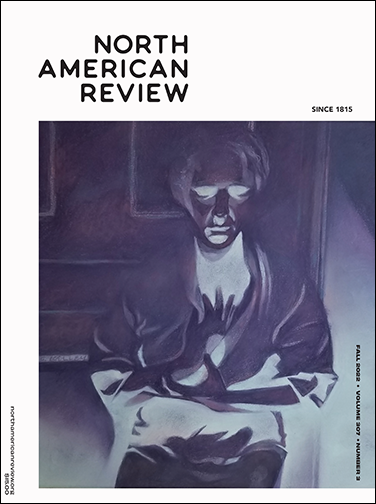307.3 Fall 2022

Buy this Issue
Never miss
a thing.
Subscribe
today.
We publish all
forms of creativity.
We like stories that start quickly
and have a strong narrative.
We appreciate when an essay
moves beyond the personal to
tell us something new about
the world.
Subscribe
FROM THE EDITORS
In May 1853 Alonzo and Sarah Newton published The “Ministry of Angels” Realized, an open letter to the members of the Edwards Congregationalist Church in Boston, which the couple had attended for years with their three young children. Alonzo even taught Sunday School there. The brief booklet articulates their newfound Spiritualist beliefs, based on experiences and communications with the spirit world. They hoped to convince the church by pointing to the miraculous foundation of the Christian faith itself as a precedent for this “new dispensation of divine truth.” The Newtons eventually broke from the church, just before they were formally excommunicated. Alonzo became a prolific editor of Spiritualist newspapers and an evangelist for Spiritualism. Sarah became a medium, undergoing an out-of-body experience and channeling the voices of “visitors from the unseen shore,” including Alonzo’s own father, as described in some detail in “Why I Am a Spiritualist,” published as one of a series of testimonial essays appearing in the North American Review’s pages in the late 1880s (“Why Am I a Moslem?” “Why Am I a Quaker?” “Why Am I an Agnostic?” and others) in which believers spell out a rationale for their religious convictions.
“Defining Spiritualism is difficult,” writes our featured artist, Shannon Taggart. “There is no official hierarchy and no doctrinal text. The only thing agreed upon in Spiritualism is a short list of tenets that profess the belief in God, ‘Natural Law,’ the ‘Golden Rule,’ communication with the ‘so-called dead,’ and the gifts of ‘prophecy and healing.’” Taggart spent eighteen years “photographing mediums, researching Spiritualism, and traveling to séance rooms across New York, the United Kingdom and Europe.” In this issue you’ll find a selection of images from Taggart’s beautiful and arresting photobook Seance, whose second edition will be available from Atelier Éditions in October. (If you are in the neighborhood early next year, stop by the University of Northern Iowa Gallery of Art to see a robust exhibition of Taggart’s photography.)
Born amid the rich ferment of progressive social movements in mid-nineteenth-century America, Spiritualism attracted abolitionists, women’s right’s activists, reformers and radicals of different stripes, those inquisitive, unconventional, and bold enough to question received dogma and accepted institutional hierarchies. As a religion, it is unique in a number of ways, not least because of the central roles that women played. They naturally held positions of prominence and authority as mediums, séances taking place in private, domestic spaces usually associated with women. Men wrote and edited material for the Spiritualist press, and some did become mediums themselves, among them the former Universalist minister John Murray Spear.
In June 1854, a year after the Newtons became full-throated Spiritualists, Sarah participated in Spear’s plan to bring forth an electromechanical Messiah called the New Motive Force, a perpetual motion machine that promised to provide the world with limitless power. It would liberate humans and allow them to devote their lives to spiritual enlightenment. By all accounts, Spear was a progressive man for his time, described as gentle and kindly. He was an active abolitionist as an operator of the Underground Railroad in Boston. He agitated for women’s rights, pacifism, socialism, labor reform, prison reform, and the end of the death penalty. Now, based on instructions received from a group of spirit friends called the Electrizers (led by the spirit of Benjamin Franklin), he had built a machine that would save the world. Sarah Newton agreed to serve as the “Mary of the New Dispensation,” whose maternal energy reportedly brought the mechanism briefly to life.
It’s impossible to know exactly what transpired 168 years ago in that cottage on High Rock Hill in Lynn, Massachusetts, where Sarah Newton ritually birthed Spear’s mechanical Messiah, but reflecting on this curious episode in the history of Spiritualism reminds us how persistently women’s bodies have been characterized, instrumentalized, or otherwise controlled as reproductive vessels. The shameful Dobbs decision by the US Supreme Court taking away the constitutional right to an abortion is only the most recent, if far-reaching, instance. The dissent makes clear the result: “the curtailment of women’s rights, and of their status as free and equal citizens.”
This issue of the NAR presents the work of artists who would stand up for freedom, equality, and bodily autonomy of various kinds. Christine G. Adams’s essay “Pleaser,” selected by Lacy M. Johnson as the winner of this year’s Terry Tempest Williams Prize in Creative Nonfiction, weaves together three embodied narrative threads: teaching bodies to swim, caring for a grandparent’s elderly body, and taking control of one’s own sexual body. Many other pained, failing, dying, and dead bodies populate the writing in these pages. We are also pleased to publish a folio of new work by NAR Contributing Editor Martín Espada, the first since his collection Floaters won the National Book Award in November. Though no Spiritualist, Espada has spent his career as a kind of literary medium, honoring the dead by listening to their voices and then singing them loudly and defiantly for the living to hear—and heed. As a touchstone for the NAR, his poetry has always been profoundly haunted, in the manner of all good art. ⬤



